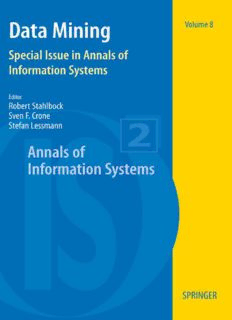Table Of ContentAnnals of Information Systems
SeriesEditors
RameshSharda
OklahomaStateUniversity
Stillwater,OK,USA
StefanVoß
UniversityofHamburg
Hamburg,Germany
Forfurthervolumes:
http://www.springer.com/series/7573
· ·
Robert Stahlbock Sven F. Crone Stefan
Lessmann
Editors
Data Mining
Special Issue in Annals of Information
Systems
123
Editors
RobertStahlbock SvenF.Crone
DepartmentofBusinessAdministration DepartmentofManagementScience
UniversityofHamburg LancasterUniversity
InstituteofInformationSystems ManagementSchool
Von-Melle-Park5 Lancaster
20146Hamburg UnitedKingdomLA14YX
Germany [email protected]
[email protected]
StefanLessmann
DepartmentofBusinessAdministration
UniversityofHamburg
InstituteofInformationSystems
Von-Melle-Park5
20146Hamburg
Germany
[email protected]
ISSN1934-3221 e-ISSN1934-3213
ISBN978-1-4419-1279-4 e-ISBN978-1-4419-1280-0
DOI10.1007/978-1-4419-1280-0
SpringerNewYorkDordrechtHeidelbergLondon
LibraryofCongressControlNumber:2009910538
(cid:2)c SpringerScience+BusinessMedia,LLC2010
Allrightsreserved.Thisworkmaynotbetranslatedorcopiedinwholeorinpartwithoutthewritten
permission of the publisher (Springer Science+Business Media, LLC, 233 Spring Street, New York,
NY10013,USA),exceptforbriefexcerptsinconnectionwithreviewsorscholarlyanalysis.Usein
connection with any form of information storage and retrieval, electronic adaptation, computer
software,orbysimilarordissimilarmethodologynowknownorhereafterdevelopedisforbidden.
The use in this publication of trade names, trademarks, service marks, and similar terms, even if
they are not identified as such, is not to be taken as an expression of opinion as to whether or not
theyaresubjecttoproprietaryrights.
Printedonacid-freepaper
SpringerispartofSpringerScience+BusinessMedia(www.springer.com)
Preface
Data mining has experienced an explosion of interest over the last two decades. It
hasbeenestablishedasasoundparadigmtoderiveknowledgefromlarge,heteroge-
neousstreamsofdata,oftenusingcomputationallyintensivemethods.Itcontinues
toattractresearchersfrommultipledisciplines,includingcomputersciences,statis-
tics, operations research, information systems, and management science. Success-
fulapplicationsincludedomainsasdiverseascorporateplanning,medicaldecision
making,bioinformatics,webmining,textrecognition,speechrecognition,andim-
age recognition, as well as various corporate planning problems such as customer
churnprediction,targetselectionfordirectmarketing,andcreditscoring.Research
in information systems equally reflects this inter- and multidisciplinary approach.
Informationsystemsresearchexceedsthesoftwareandhardwaresystemsthatsup-
portdata-intensiveapplications,analyzingthesystemsofindividuals,data,andall
manual or automated activities that process the data and information in a given
organization.
TheAnnalsofInformationSystemsdevotesaspecialissuetotopicsattheinter-
section of information systems and data mining in order to explore the synergies
between information systems and data mining. This issue serves as a follow-up to
the International Conference on Data Mining (DMIN) which is annually held in
conjunction within WORLDCOMP, the largest annual gathering of researchers in
computer science, computer engineering, and applied computing. The special is-
sueincludessignificantlyextendedversionsofpriorDMINsubmissionsaswellas
contributionswithoutDMINcontext.
We would like to thank the members of the DMIN program committee. Their
supportwasessentialforthequalityoftheconferencesandforattractinginteresting
contributions. We wish to express our sincere gratitude and respect toward Hamid
R.Arabnia,generalchairofallWORLDCOMPconferences,forhisexcellentand
tirelesssupport,organization,andcoordinationofallWORLDCOMPconferences.
Moreover,wewouldliketothankthetwoserieseditors,RameshShardaandStefan
Voß,fortheirvaluableadvice,support,andencouragement.Wearegratefulforthe
pleasant cooperation with Neil Levine, Carolyn Ford, and Matthew Amboy from
Springer and their professional support in publishing this volume. In addition, we
v
vi Preface
wouldliketothankthereviewersfortheirtimeandtheirthoughtfulreviews.Finally,
wewouldliketothankallauthorswhosubmittedtheirworkforconsiderationtothis
focusedissue.Theircontributionsmadethisspecialissuepossible.
Hamburg,Germany RobertStahlbock
Hamburg,Germany StefanLessmann
Lancaster,UK SvenF.Crone
Contents
1 DataMiningandInformationSystems:QuoVadis?............... 1
RobertStahlbock,StefanLessmann,andSvenF.Crone
1.1 Introduction.............................................. 1
1.2 SpecialIssuesinDataMining............................... 3
1.2.1 ConfirmatoryDataAnalysis......................... 3
1.2.2 KnowledgeDiscoveryfromSupervisedLearning....... 4
1.2.3 ClassificationAnalysis ............................. 6
1.2.4 HybridDataMiningProcedures ..................... 8
1.2.5 WebMining ...................................... 10
1.2.6 Privacy-PreservingDataMining ..................... 11
1.3 ConclusionandOutlook.................................... 12
References..................................................... 13
PartI ConfirmatoryDataAnalysis
2 Response-BasedSegmentationUsingFiniteMixturePartialLeast
Squares.................................................... 19
ChristianM.Ringle,MarkoSarstedt,andErikA.Mooi
2.1 Introduction.............................................. 20
2.1.1 OntheUseofPLSPathModeling ................... 20
2.1.2 ProblemStatement ................................ 22
2.1.3 ObjectivesandOrganization ........................ 23
2.2 PartialLeastSquaresPathModeling ......................... 24
2.3 FiniteMixturePartialLeastSquaresSegmentation ............. 26
2.3.1 Foundations ...................................... 26
2.3.2 Methodology ..................................... 28
2.3.3 SystematicApplicationofFIMIX-PLS................ 31
2.4 ApplicationofFIMIX-PLS ................................. 34
2.4.1 OnMeasuringCustomerSatisfaction ................. 34
2.4.2 DataandMeasures ................................ 34
2.4.3 DataAnalysisandResults .......................... 36
vii
viii Contents
2.5 SummaryandConclusion .................................. 44
References..................................................... 45
PartII KnowledgeDiscoveryfromSupervisedLearning
3 BuildingAcceptableClassificationModels ...................... 53
DavidMartensandBartBaesens
3.1 Introduction.............................................. 54
3.2 ComprehensibilityofClassificationModels ................... 55
3.2.1 MeasuringComprehensibility ....................... 57
3.2.2 ObtainingComprehensibleClassificationModels....... 58
3.3 JustifiabilityofClassificationModels......................... 59
3.3.1 TaxonomyofConstraints ........................... 60
3.3.2 MonotonicityConstraint............................ 62
3.3.3 MeasuringJustifiability ............................ 63
3.3.4 ObtainingJustifiableClassificationModels ............ 68
3.4 Conclusion............................................... 70
References..................................................... 71
4 Mining Interesting Rules Without Support Requirement: A
GeneralUniversalExistentialUpwardClosureProperty .......... 75
YannickLeBras,PhilippeLenca,andSte´phaneLallich
4.1 Introduction.............................................. 76
4.2 StateoftheArt ........................................... 77
4.3 AnAlgorithmicPropertyofConfidence ...................... 80
4.3.1 OnUEUCFramework ............................. 80
4.3.2 TheUEUCProperty ............................... 80
4.3.3 AnEfficientPruningAlgorithm...................... 81
4.3.4 GeneralizingtheUEUCProperty .................... 82
4.4 AFrameworkfortheStudyofMeasures ...................... 84
4.4.1 AdaptedFunctionsofMeasure ...................... 84
4.4.2 ExpressionofaSetofMeasuresofD ............. 87
dconf
4.5 ConditionsforGUEUC .................................... 90
4.5.1 ASufficientCondition ............................. 90
4.5.2 ANecessaryCondition............................. 91
4.5.3 ClassificationoftheMeasures ....................... 92
4.6 Conclusion............................................... 94
References..................................................... 95
5 ClassificationTechniquesandErrorControlinLogicMining ...... 99
GiovanniFelici,BrunoSimeone,andVincenzoSpinelli
5.1 Introduction..............................................100
5.2 BriefIntroductiontoBoxClustering .........................102
5.3 BC-BasedClassifier .......................................104
5.4 BestChoiceofaBoxSystem ...............................108
5.5 Bi-criterionProcedureforBC-BasedClassifier.................111
Contents ix
5.6 Examples................................................112
5.6.1 TheDataSets.....................................112
5.6.2 ExperimentalResultswithBC.......................113
5.6.3 ComparisonwithDecisionTrees.....................115
5.7 Conclusions..............................................117
References.....................................................117
PartIII ClassificationAnalysis
6 AnExtendedStudyoftheDiscriminantRandomForest ........... 123
Tracy D. Lemmond, Barry Y. Chen, Andrew O. Hatch,
andWilliamG.Hanley
6.1 Introduction..............................................123
6.2 RandomForests ..........................................124
6.3 DiscriminantRandomForests...............................125
6.3.1 LinearDiscriminantAnalysis .......................126
6.3.2 TheDiscriminantRandomForestMethodology ........127
6.4 DRFandRF:AnEmpiricalStudy ...........................128
6.4.1 HiddenSignalDetection............................129
6.4.2 RadiationDetection................................132
6.4.3 SignificanceofEmpiricalResults ....................136
6.4.4 SmallSamplesandEarlyStopping ...................137
6.4.5 ExpectedCost ....................................143
6.5 Conclusions..............................................143
References.....................................................145
7 PredictionwiththeSVMUsingTestPointMargins ............... 147
Su¨reyyaO¨zo¨g˘u¨r-Akyu¨z,ZakriaHussain,andJohnShawe-Taylor
7.1 Introduction..............................................147
7.2 Methods.................................................151
7.3 DataSetDescription.......................................154
7.4 Results ..................................................154
7.5 DiscussionandFutureWork ................................155
References.....................................................157
8 Effects of Oversampling Versus Cost-Sensitive Learning for
BayesianandSVMClassifiers................................. 159
AlexanderLiu,CherylMartin,BrianLaCour,andJoydeepGhosh
8.1 Introduction..............................................159
8.2 Resampling ..............................................161
8.2.1 RandomOversampling.............................161
8.2.2 GenerativeOversampling...........................161
8.3 Cost-SensitiveLearning....................................162
8.4 RelatedWork.............................................163
8.5 ATheoreticalAnalysisofOversamplingVersusCost-Sensitive
Learning.................................................164
x Contents
8.5.1 BayesianClassification.............................164
8.5.2 Resampling Versus Cost-Sensitive Learning in
BayesianClassifiers ...............................165
8.5.3 EffectofOversamplingonGaussianNaiveBayes ......166
8.5.4 EffectsofOversamplingforMultinomialNaiveBayes ..168
8.6 EmpiricalComparisonofResamplingandCost-Sensitive
Learning.................................................170
8.6.1 ExplainingEmpiricalDifferencesBetweenResampling
andCost-SensitiveLearning ........................170
8.6.2 Naive Bayes Comparisons on Low-Dimensional
GaussianData ....................................171
8.6.3 MultinomialNaiveBayes...........................176
8.6.4 SVMs ...........................................178
8.6.5 Discussion .......................................181
8.7 Conclusion...............................................182
Appendix ......................................................183
References.....................................................190
9 TheImpactofSmallDisjunctsonClassifierLearning ............. 193
GaryM.Weiss
9.1 Introduction..............................................193
9.2 AnExample:TheVoteDataSet .............................195
9.3 DescriptionofExperiments.................................197
9.4 TheProblemwithSmallDisjuncts ...........................198
9.5 TheEffectofPruningonSmallDisjuncts .....................202
9.6 TheEffectofTrainingSetSizeonSmallDisjuncts .............210
9.7 TheEffectofNoiseonSmallDisjuncts.......................213
9.8 TheEffectofClassImbalanceonSmallDisjuncts..............217
9.9 RelatedWork.............................................220
9.10 Conclusion...............................................223
References.....................................................225
PartIV HybridDataMiningProcedures
10 PredictingCustomerLoyaltyLabelsinaLargeRetailDatabase:A
CaseStudyinChile.......................................... 229
Cristia´nJ.Figueroa
10.1 Introduction..............................................229
10.2 RelatedWork.............................................231
10.3 ObjectivesoftheStudy ....................................233
10.3.1 SupervisedandUnsupervisedLearning ...............234
10.3.2 UnsupervisedAlgorithms...........................234
10.3.3 VariablesforSegmentation .........................238
10.3.4 ExploratoryDataAnalysis ..........................239
10.3.5 ResultsoftheSegmentation.........................240
10.4 ResultsoftheClassifier ....................................241
Description:Over the course of the last twenty years, research in data mining has seen a substantial increase in interest, attracting original contributions from various disciplines including computer science, statistics, operations research, and information systems. Data mining supports a wide range of applica

